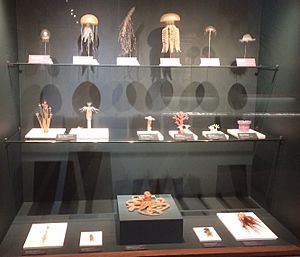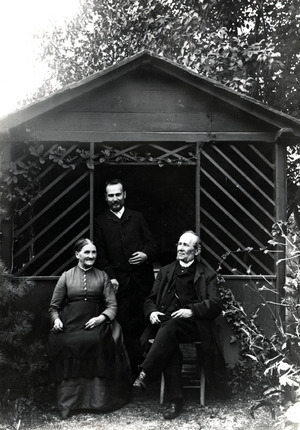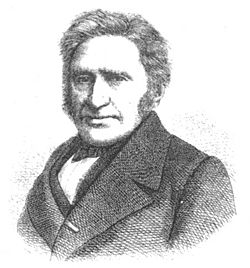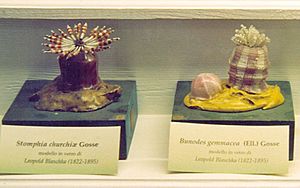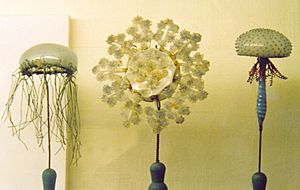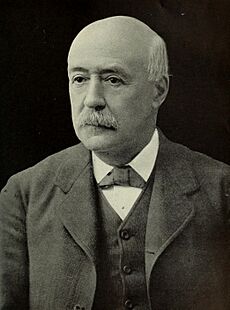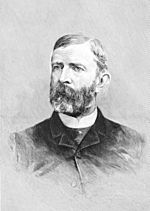Glass sea creatures facts for kids
The glass sea creatures are amazing glass models of animals that live in the ocean, like jellyfish and sea anemones. They were made by two skilled glass artists, Leopold and Rudolf Blaschka, a father and son team. These beautiful models were created to help museums and schools teach people about marine life.
Between 1863 and 1880, the Blaschkas, working in Dresden, Germany, made at least 10,000 of these very detailed glass models. They represented about 700 different kinds of sea creatures. Many large collections of these models are now kept in museums and universities around the world. For example, Harvard University has many of them, and Cornell University has about 570 models. The largest collection in Europe, with 530 pieces, is at Ireland's Natural History Museum.
Contents
How the Glass Sea Creatures Started
In 1853, Leopold Blaschka went on a trip to the United States. On the way, his ship was stuck at sea for two weeks because there was no wind. During this time, Leopold spent his days studying and drawing the sea animals around the ship. He was fascinated by how transparent their bodies were, much like the glass his family worked with.
Leopold felt a deep sense of wonder looking at these glowing ocean creatures. He wrote about how the sea would light up with "thousands of sparks" and "bright shining sunlike figures." This feeling of wonder later inspired his work.
When he returned to Dresden, Leopold continued his family business, which involved making glass eyes and other special glass items. But he also had a hobby: making glass models of plants. This hobby eventually led to the famous "Glass Flowers" collection. His plant models were so good that they caught the eye of Prince Camille de Rohan, who loved nature. The Prince asked the Blaschkas to make 100 glass orchids for his collection. The Prince was very impressed and showed these models in his palace. This helped the Blaschkas' amazing skills become known to others, including a man named Ludwig Reichenbach.
Reichenbach's Special Request
Professor Reichenbach was the director of the natural history museum in Dresden. He had a big problem: how to display sea animals. It was easy to show land animals like gorillas by stuffing them. But sea creatures, especially those without hard shells, were tricky. When they were put in jars of alcohol for display, they would lose their color and turn into shapeless blobs over time. This made them hard to study and not very interesting for visitors.
Professor Reichenbach wanted something better: 3D, colorful models of marine invertebrates that looked real and would last a long time. In 1863, he saw an exhibition of Leopold Blaschka's incredibly detailed glass flowers.
He was amazed by the glass plants and knew Leopold could solve his problem. So, in 1863, Reichenbach asked Leopold to create twelve glass models of sea anemones. These glass sea creatures were a huge improvement over old methods like drawings or wax models. They were praised as "an artistic marvel in the field of science." They also gave Leopold a way to express the wonder he felt when he first saw the glowing ocean life.
The most important thing was that these glass models looked "perfectly true to nature." Professor Reichenbach was so happy with his new glass sea creatures that he advised Leopold to stop making other glass items and focus on selling these marine models to museums, aquariums, and universities around the world. Leopold took his advice, and it turned out to be a very smart decision.
A Successful Business for Glass Sea Creatures
Unlike the later Glass Flowers, which were made for just one university, the Blaschka glass sea creatures became a worldwide business. People everywhere, not just museums, were very interested in the natural world during the late 1800s. Home aquariums became popular, and deep-sea diving showed people amazing new creatures. It became fashionable to have examples of nature in one's home.
The Blaschkas realized this and started a mail-order business. This meant people could order their glass models from a catalog and have them shipped. This business was incredibly successful. They made and sold 10,000 glass invertebrates that were sent all over the globe. People had never seen anything like the beautiful and scientifically accurate Blaschka models, and they were easy to get. For example, a small glass octopus could be bought for about $2.50.
Museums and universities bought many of these models because directors around the world faced the same problem as Professor Reichenbach: how to display marine invertebrates. The Blaschka mail-order business succeeded for two main reasons:
- There was a huge demand for these models worldwide.
- The Blaschkas were the only and best glass artists who could create such scientifically perfect models.
At first, Leopold based his designs on drawings from books. But soon, he used his own earlier sketches to create even more detailed models of different species. His reputation quickly grew. Leopold even built an aquarium at his home so he could keep live specimens to study and model from.
The success of the marine invertebrate business eventually connected to Harvard University's Museum of Comparative Zoology. Around 1859, a collection of 430 glass sea creatures was bought by either the museum's first director, Louis Agassiz, or his son, Alexander Agassiz. This collection, though not the largest, would play a very important role in the Blaschkas' future work.
From Sea Creatures to Glass Flowers
The glass sea creatures sold to Harvard became very important because Harvard was planning to open a new Botanical Museum in 1888. The first director, George Lincoln Goodale, faced a problem similar to Reichenbach's. Harvard was a leading center for studying plants, and Professor Goodale wanted the best teaching tools for his students. However, the usual way to display plants was to press them flat. This made them two-dimensional and they often lost their color, which was not ideal for teaching.
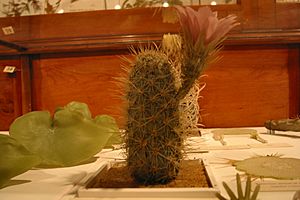
Like Professor Reichenbach, Professor Goodale learned about the Blaschkas' skill from an exhibition. He saw the glass marine invertebrates at Harvard's Museum of Comparative Zoology. Goodale immediately knew that the Blaschkas' work was the answer to his problem.
So, in 1886, Goodale asked the Blaschkas to make a series of glass plant models for Harvard. At first, Leopold was not keen because his business of selling glass sea creatures was doing very well. But eventually, the famous glass artists agreed to send some test models to the U.S. Even though these models were damaged during shipping, the fragments convinced Goodale that Blaschka glass art was a worthwhile investment for education.
With generous support from Elizabeth C. Ware and her daughter Mary, an initial contract was signed. It allowed the Blaschkas to work part-time on the plant models, so they could continue making their glass sea creatures. However, in 1890, they signed an updated agreement that allowed Leopold and Rudolf to work on the Glass Flowers full-time. This meant the production of the glass sea creatures slowed down, and the Blaschkas' focus shifted to the Glass Flowers project. This project continued for fifty years, ending with Rudolf Blaschka's death.
The Models Today
Today, more than a century after they were made, the glass sea creatures are less famous than their plant cousins, the Glass Flowers. Many people who know about the Glass Flowers have never even heard of the sea creatures. For a while, these glass animals were forgotten and stored away in dusty closets. However, recently, people have started to remember and rediscover these incredible models.
Corning Museum of Glass
The Corning Museum of Glass has the largest known collection of Blaschka sea creatures, with 700 models bought in 1888. Some of these are displayed in an exhibition called Fragile Legacy. Researchers at Cornell University are using this collection like a time capsule to study and document creatures still living in our oceans today. The exhibit also allowed visitors to try making glass sea slugs.
Harvard University
Even the models at Harvard's Museum of Comparative Zoology (MCZ) were somewhat neglected. They were not forgotten, but they were spread across different departments. For a long time, people thought Harvard only had 60-70 models, when they actually had 430. Recently, Harvard has restored and repaired many of these glass sea creatures with the help of Elizabeth R. Brill, a glass worker and marine biologist. Today, they are part of the Harvard Museum of Natural History's Sea Creatures in Glass display. When combined with the Glass Flowers, this forms the largest Blaschka collection on display anywhere in the world.
For a few months in 2015 and 2016, Harvard's museum had a special temporary display. It showed some of the most popular glass plant models along with some glass sea creatures. This was the first time the Glass Flowers and Glass sea creatures were displayed together in a major exhibit. The sea creatures remained a permanent exhibit in that location until 2020, when they moved to their own nearby room and exhibit.
Cornell University
In 1885, Andrew Dixon White, the first president of Cornell University, approved the purchase of 570 glass marine invertebrates. Some of these are now on display at Corson Mudd Hall and the Herbert F. Johnson Museum. This makes Cornell one of the few universities where students and the public can see these amazing creations. Like many other collections, they were neglected for a while, forgotten until the late 20th century. Cornell has restored about 170 of the models so far and plans to continue as funding allows.
National Museum of Ireland
The Natural History Museum in Dublin, Ireland, was one of the Blaschkas' earliest customers. They first ordered 85 glass models and later bought 530 models in total. This makes it the largest collection of Blaschka Invertebrate Models in Europe. The museum has also done research on how to preserve these delicate objects. The National Museum of Ireland is an important center for learning about the Blaschkas. In 2006, they hosted the Dublin Blaschka Congress, a meeting that brought together experts from different fields to study scientific glass models.
Field Museum of Natural History
The Field Museum of Natural History in Chicago has a number of glass models, including shells and sea slugs. Many of these were displayed at the 1893 World's Columbian Exposition and were later bought by the museum. Today, many are on display in their permanent exhibit called What is an Animal?.
Natural History Museum, London
The Natural History Museum, London holds 182 of the Blaschka models.
Museum of Science (Boston)
The Museum of Science (MoS) in Boston has a small display of marine invertebrates near the end of their Natural Mysteries exhibit.
D'Arcy Thompson Zoology Museum
The D'Arcy Thompson Zoology Museum at the University of Dundee in Scotland displays Blaschka models of marine invertebrates. The museum's founder, Scottish biologist and mathematician D'Arcy Thompson, bought these models in 1888 to use as teaching tools.
University of Vienna
The University of Vienna has a collection of 145 glass marine invertebrates. This is the second largest collection of Blaschka models in the German-speaking part of Europe. The collection was used for teaching until the 1930s and was rediscovered in the 1980s. In 2016, the collection was loaned to and displayed at the Naturhistorisches Museum Wien.
Natural History Museum of the University of Pisa
The Natural History Museum of the University of Pisa in Italy has one of the few glass marine invertebrate model collections in the country. It has 51 models of marine invertebrates that were made for teaching purposes.
Lost Works
Many of the glass sea creatures are still missing. Leopold Blaschka's records show where many shipments went, but the condition and current location of most of these collections are unknown. Sadly, the original six glass sea anemones that Professor Reichenbach bought in 1863, along with the rest of that first collection, were destroyed during the bombing of Dresden in World War II.
See also
- Lampworking
- Glassblowing


